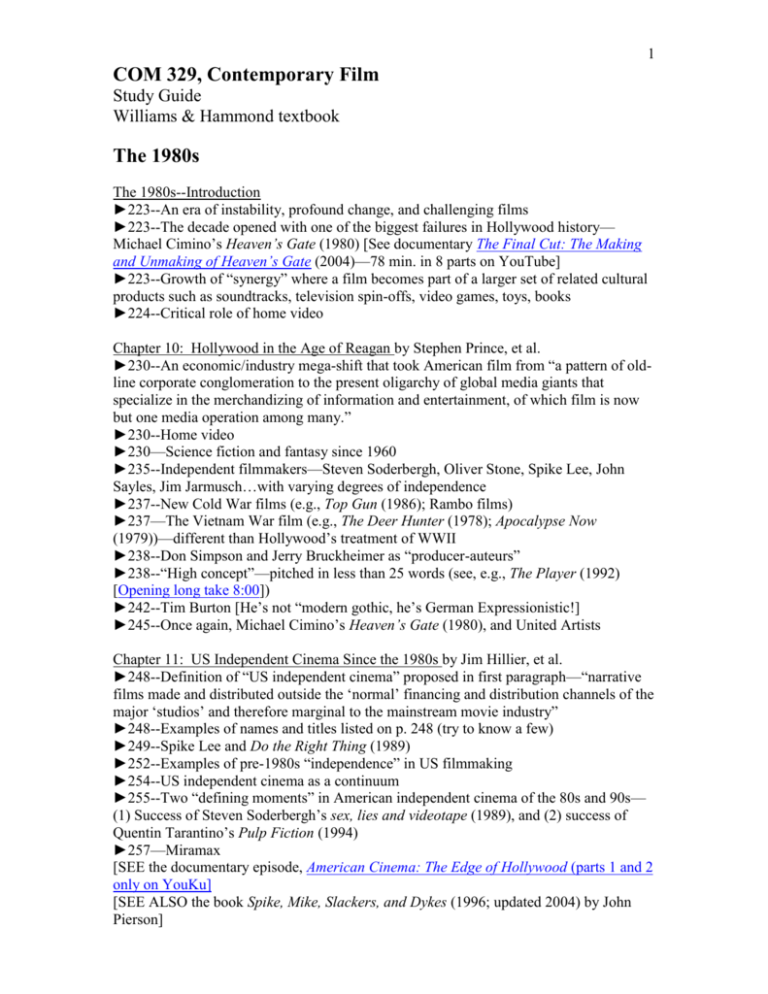COM 329, Contemporary Film
advertisement

1 COM 329, Contemporary Film Study Guide Williams & Hammond textbook The 1980s The 1980s--Introduction ►223--An era of instability, profound change, and challenging films ►223--The decade opened with one of the biggest failures in Hollywood history— Michael Cimino’s Heaven’s Gate (1980) [See documentary The Final Cut: The Making and Unmaking of Heaven’s Gate (2004)—78 min. in 8 parts on YouTube] ►223--Growth of “synergy” where a film becomes part of a larger set of related cultural products such as soundtracks, television spin-offs, video games, toys, books ►224--Critical role of home video Chapter 10: Hollywood in the Age of Reagan by Stephen Prince, et al. ►230--An economic/industry mega-shift that took American film from “a pattern of oldline corporate conglomeration to the present oligarchy of global media giants that specialize in the merchandizing of information and entertainment, of which film is now but one media operation among many.” ►230--Home video ►230—Science fiction and fantasy since 1960 ►235--Independent filmmakers—Steven Soderbergh, Oliver Stone, Spike Lee, John Sayles, Jim Jarmusch…with varying degrees of independence ►237--New Cold War films (e.g., Top Gun (1986); Rambo films) ►237—The Vietnam War film (e.g., The Deer Hunter (1978); Apocalypse Now (1979))—different than Hollywood’s treatment of WWII ►238--Don Simpson and Jerry Bruckheimer as “producer-auteurs” ►238--“High concept”—pitched in less than 25 words (see, e.g., The Player (1992) [Opening long take 8:00]) ►242--Tim Burton [He’s not “modern gothic, he’s German Expressionistic!] ►245--Once again, Michael Cimino’s Heaven’s Gate (1980), and United Artists Chapter 11: US Independent Cinema Since the 1980s by Jim Hillier, et al. ►248--Definition of “US independent cinema” proposed in first paragraph—“narrative films made and distributed outside the ‘normal’ financing and distribution channels of the major ‘studios’ and therefore marginal to the mainstream movie industry” ►248--Examples of names and titles listed on p. 248 (try to know a few) ►249--Spike Lee and Do the Right Thing (1989) ►252--Examples of pre-1980s “independence” in US filmmaking ►254--US independent cinema as a continuum ►255--Two “defining moments” in American independent cinema of the 80s and 90s— (1) Success of Steven Soderbergh’s sex, lies and videotape (1989), and (2) success of Quentin Tarantino’s Pulp Fiction (1994) ►257—Miramax [SEE the documentary episode, American Cinema: The Edge of Hollywood (parts 1 and 2 only on YouKu] [SEE ALSO the book Spike, Mike, Slackers, and Dykes (1996; updated 2004) by John Pierson] 2 Chapter 12: Disney and Family Entertainment by Peter Kramer ►266--The Disney model (inc. cross-promotional, synergistic relationship among the company’s various activities) ►267--Disney’s live action films in 60s and 70s [See 2008 documentary, The Age of Believing: The Disney Live Action Classics—excerpt 7:00 total] ►272--Touchstone label—becoming more like other studios, and vice versa ►277--Possibility of a “culturally homogenized globe on which, from an early age, the majority of children are exposed to, seduced by and absorbed into the fantasy worlds of The Lion King, Star Wars”, etc. [Compare this to Studio Ghibli] Chapter 13: The Vietnam War in American Cinema by Susan Jeffords ►282--Robert Altman’s M*A*S*H (1970) and subsequent anti-war films (although not all were set in the Vietnam War) [trailer] [Altman on “Independent Focus” 27:00 total] ►283--Michael Cimino’s The Deer Hunter (1978) [wedding clip—filmed in Cleveland…St. Theodosius Russian Orthodox Cathedral, Lemko Hall] [Cimino on ”Filmschoolthrucommentaries” talking about filmmaking technique 14:30 total] ►283--Francis Ford Coppolla’s Apocalypse Now (1979) [“Ride of the Valkyries” clip] Chapter 14: The 1980s and American Documentary by Carl Plantinga ►289--Documentaries’ “unprecedented success in theatrical distribution” ►291--Michael Moore ►292--Direct cinema and Frederick Wiseman [and Zipporah Films] ►293--Errol Morris and re-enactments ►295--Les Blank [1935-2013; At his website, see trailers for most of his films] ►297--The MTV aesthetic Chapter 15: Women in Recent US Cinema by Linda Ruth Williams ►299--Dorothy Arzner [KickStarter doc project] and Ida Lupino [Ida Lupino: Through the Lens (1998) 44:00 total]—“the only female directors to develop significant bodies of work in classical Hollywood” ►300--Amy Kaplan’s four phases of women’s film history in the US ►300--Polly Platt [1939-2011] [interview 2:00 total] ►303--Nora Ephron [1941-2012] [On “Makers” 4:15 total] ►303--Susan Seidelman and Desperately Seeking Susan (1985) ►311--Rachel Abramovitz’s observation that women have worked in “an industry dominated not just by men but by the likes and dislikes of the young male consumer. . . “ ►311--Julia Phillips and Sherry Lansing ►313—Callie Khouri, who won an Oscar for the screenplay for Thelma & Louise (1991) [On “Makers” 5:00 total]











